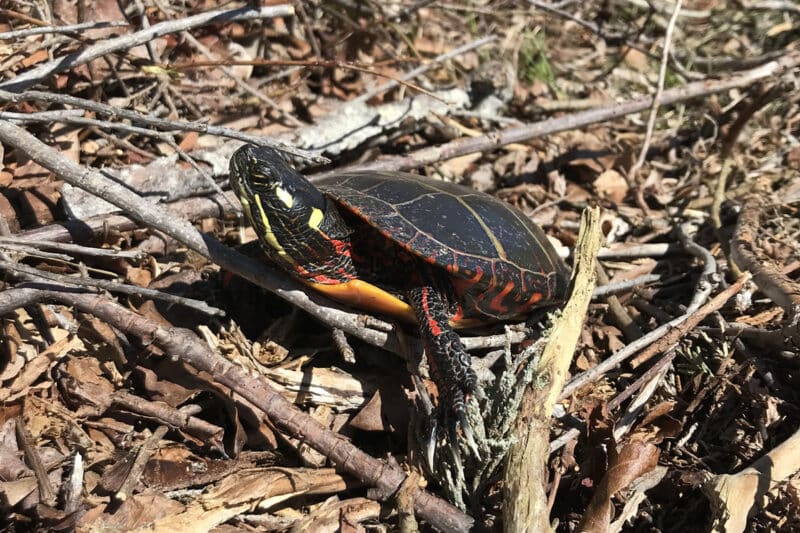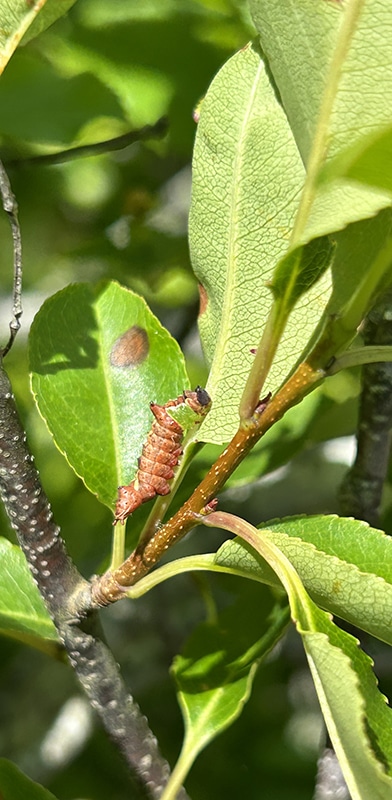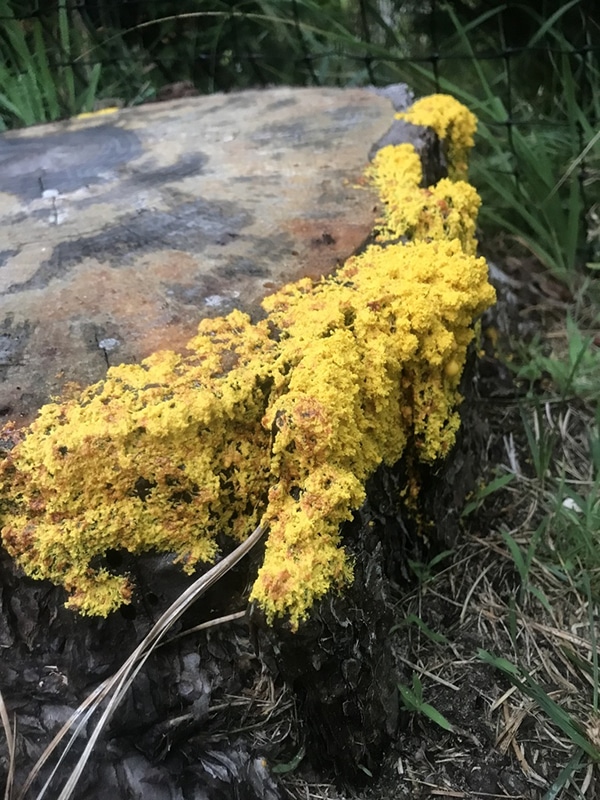by Dr. Sarah Treanor Bois, PhD
Director of Research & Education at the Linda Loring Nature Foundation
Last week I was walking the Linda Loring Nature Foundation trails with two of our summer research and conservation volunteers. While we were examining some of our research trees, I noticed something different. There was a small, green and brown creature perched on the edge of a leaf. It had great camouflage, but the slight movement told me it wasn’t part of the leaf as it would like me to believe.
“What is that?” the volunteer asked. I should have all the answer, right? But as a plant ecologist, caterpillars and insects in general are something I am constantly learning. This became a demonstration opportunity in using one of my favorite tools, iNaturalist. I took a photo of the creature which only measured about 2cm and uploaded it to the app. Right away, the app suggested it was a Unicorn Prominent (Coelodasys unicornis). We had found a unicorn! The identification was confirmed a day later.
I had never seen a Unicorn Prominent before, and, together with my volunteers, we marveled at its ability to blend in perfectly with the black cherry leaves. We learned that the Unicorn Prominent becomes a moth (which look sort of unremarkable), but that as a larva (the caterpillar stage), it can be found from June to September in our area. It’s named for the horn-like protuberance on its first abdominal segment. It is green and brown and will ultimately grow up to 4cm. They cocoon beneath leaf litter, overwinter, and emerge in the spring, when we might get to discover it again as an adult!
This “discovery” of something not uncommon in our area is one of the reasons we began our Nantucket BioBlitz four years ago. Initiated by the Nantucket Land and Water Council (NLWC) in 2020, the Linda Loring Nature Foundation (LLNF) and the NLWC now partner on the Nantucket BioBlitz to document biodiversity across the island.
A BioBlitz is traditionally a short period of time when people (experts from different taxa as well as community members) catalog all forms of life in a specific area. Nantucket is a great place for this since we have an easily-defined geographic boundary: we have a moat! For the past 4 years, our BioBlitz has been held during the entire month of July, peak growing season. This year, we are concentrating the Blitz to cover 2 weeks in mid-July to get closer to an actual “blitz.”
From July 13 through the 26 , all flora and fauna of Nantucket County is fair game. That include Tuckernuck and Muskeget Islands, if you are lucky enough to get out there. Using the iNaturalist app (a free database and identification project) anyone can observe something in nature, take a photo, and upload it. It’s that simple. You don’t even need to know exactly what it is. The algorithm of iNaturalist uses photo recognition, previous sightings, and location to identify your find. An added benefit is that experts from around the globe will verify (or correct) the identification, elevating it to “research grade.”
iNaturalist is one of the most popular nature apps in the world, helping people identify plants, animals, insects, microbes, etc. As of this writing, there are more than 197 million observations from around the world, documenting more than 480,000 species. This huge database is used by scientists to track different aspects of nature. By recording and sharing observations, you create researchquality data for scientists working to better understand and protect nature.
In addition to the important data contribution, the BioBlitz is a fun reason to get out and take a closer look at some of your favorite places around Nantucket. By surveying all we see, we learn more about our natural communities. A BioBlitz promotes and, hopefully, improves local natural spaces by empowering community members to better understand and protect biodiversity.
From a scientific point if view, we collect data on what species are around the island, where and when. This kind of inventory of all species can highlight new things not seen before. It also helps us see the richness of our ecosystem: “richness” is the overall number of species.
In addition to the sheer number of species, we get information on what they are doing. The phenology, or timing of natural events, give us insight into how species may be changing with a changing climate. For example, when the pasture roses are blooming, when monarch caterpillars are seen, and when the blueberries are ripe—all phenological events typical in July.
Check out the BioBlitz page for all the information you need to join the project (llnf.org/bioblitz24). You can also find links to more information about how to use iNaturalist. We’ll be adding info on that page throughout the BioBlitz.
To participate, head out to any location on-island with your smartphone, snap a picture of the species you see, upload to the iNaturalist app, and join NLC and LLNF for Bioblitz 2024. You can document nearly any living thing you find— fish, crabs, insects, flowers, trees, and more—to help document the many special species found here on Nantucket Island.
One of the benefits of this BioBlitz is that people can join at their comfort level. Once you have iNaturalist app, you can go it alone and log in observations. The morning of July 19, Linda Loring Nature Foundation is offering a chance to learn on a guided field trip at the property, covering a diversity of habitats. The field trip is free, but registration is required in advance at llnf.org/events. This is a great way to practice using iNaturalist and get a feel for how it works.
One of my favorite things each year is seeing what people observe. In 2023, the top species observed reflect the common species blooming or otherwise obvious in July: Common Yarrow, Northern Bayberry, Eastern Bumblebee, and Herring Gulls. Despite being the same time of year, 2022 had a different suite of top observed species, reflecting the interests of the participants as well as what’s around. That year, Common Milkweed dominated, followed by Great Mullein, Beach Rose, Eastern Cottontail Rabbits, and Osprey.
The highest richness achieved was in 2021 with 863 species. However, the greatest number of total observations was in 2023 with 3,051 observations made during the BioBlitz. We’re hoping to have similar numbers this year even with the shortened duration for the BioBlitz.
Here are a few highlights from last year that were unusual or surprising, or, at least, weird enough to inspire us all to learn a little more about some of our Nantucket creatures!
Dog Vomit Slime Mold (Fuligo septica) is an annual favorite. The name certainly is descriptive. This slime mold has been seen during every BioBlitz, and it’s often new to people. A new sighting for me was the Black Witch Butterfly (Ascalapha odorata). This moth is a large, bat-shaped, dark-colored nocturnal moth. It is the largest noctuoid in the continental United States. According to Wikipedia, in the folklore of many Central American cultures, it is associated with death or misfortune. It was seen last year at the end of July as an adult moth. Despite its association, I hope to see one!
Sometimes it’s the name of the species that is the most interesting. Wolf’s Milk (Lycogala epidendrum) is the common name for the small, bloblike pink fungus that sometimes dots downed logs in places like Squam. Other species are now present on our BioBlitz which never used to be seen. Lone-star ticks, for example, are now common across the island and that’s reflected in our BioBlitz observations.
To see some of the species from previous years, check out the project pages in iNaturalist: inaturalist.org/projects/nlc-and-llnf-bioblitz-2022?tab=species, and inaturalist.org/projects/nantucket-bioblitz-2023?tab=species. Let’s see what we can do to match or surpass some of those observations!
This year, to share in the observations and delight, jointly, in what we find, LLNF and NLWC are hosting an end-of-the-blitz recap party the afternoon of Friday July 26 for those who participate. We’ll go over highlights of the BioBlitz, compare to previous years, and talk about some fun finds. Details on where and when we are gathering will be posted on llnf.org/bioblitz24.





